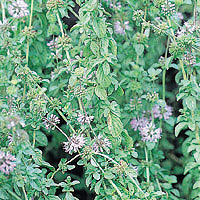health guides
Pennyroyal
 © Martin Wall
© Martin WallParts Used & Where Grown
Two similar plants go by the name pennyroyal, one native to Europe (and therefore called European pennyroyal) and one native to North America (and therefore called American pennyroyal). Both are members of the mint family (Lamiaceae) and grow in temperate regions of Europe and the Americas. The flowering tops are used as medicine, but the internal use of the volatile oil should be strictly avoided.
- Reliable and relatively consistent scientific data showing a substantial health benefit.
- Contradictory, insufficient, or preliminary studies suggesting a health benefit or minimal health benefit.
- For an herb, supported by traditional use but minimal or no scientific evidence. For a supplement, little scientific support.
Our proprietary “Star-Rating” system was developed to help you easily understand the amount of scientific support behind each supplement in relation to a specific health condition. While there is no way to predict whether a vitamin, mineral, or herb will successfully treat or prevent associated health conditions, our unique ratings tell you how well these supplements are understood by the medical community, and whether studies have found them to be effective for other people.
For over a decade, our team has combed through thousands of research articles published in reputable journals. To help you make educated decisions, and to better understand controversial or confusing supplements, our medical experts have digested the science into these three easy-to-follow ratings. We hope this provides you with a helpful resource to make informed decisions towards your health and well-being.
This supplement has been used in connection with the following health conditions:
| Used for | Amount | Why |
|---|---|---|
Anxiety | Refer to label instructions | Pennyroyal is one of a group of “nerve tonic” (nervine) herbs used in traditional herbal medicine for people with anxiety, with few reports of toxicity.
|
Cough | Refer to label instructions | Pennyroyal has a long history of use for relieving coughs. |
Insect Bites and Stings | Refer to label instructions | Since the time of the ancient Greeks, pennyroyal has been considered a useful insect repellant, reflected in modern times by the common name fleabane. |
Traditional Use (May Not Be Supported by Scientific Studies)
Since the time of the ancient Greeks, pennyroyal was considered a useful insect repellant, reflected in modern times by the common name fleabane.1 The Latin names of both plants also reflect this insect-repelling power—pulegoides and pulegium both derive from the Latin word for flea. It was also believed to stimulate menstruation. Various folk herb traditions have employed American or European pennyroyal to help relieve coughs, upset stomachs, and anxiety.2
Copyright © 2024 TraceGains, Inc. All rights reserved.
Learn more about TraceGains, the company.
The information presented by TraceGains is for informational purposes only. It is based on scientific studies (human, animal, or in vitro), clinical experience, or traditional usage as cited in each article. The results reported may not necessarily occur in all individuals. Self-treatment is not recommended for life-threatening conditions that require medical treatment under a doctor's care. For many of the conditions discussed, treatment with prescription or over the counter medication is also available. Consult your doctor, practitioner, and/or pharmacist for any health problem and before using any supplements or before making any changes in prescribed medications. Information expires December 2024.


 We are proud to announce that
We are proud to announce that  As the market evolves, customers increasingly request a wider variety of omega-3 options for their lipid...
As the market evolves, customers increasingly request a wider variety of omega-3 options for their lipid...  Maintaining healthy glucose levels is crucial for preventing metabolic conditions like diabetes,...
Maintaining healthy glucose levels is crucial for preventing metabolic conditions like diabetes,...  Looking at formulating a new vitamin blend? Discover
Looking at formulating a new vitamin blend? Discover 







































